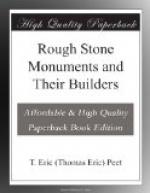The first type occurs in the southern counties, in the islands of the west and north coasts, and also extends into Argyll and Perthshire. The most famous example is the Callernish Circle in the Isle of Lewis. The circle is formed by thirteen stones from 12 to 15 feet high, and its centre is marked by an upright 17 feet high. From the circle extends a line of four stones to the east and another to the west. To the south runs a line of five uprights and several fallen stones, and to the N.N.E. runs a double line, forming as it were an avenue with nine stones on one side and ten on the other, but having no entrance to the circle. Inside the circle, between the central stone and the east side of the ring, is what is described as a cruciform grave with three cells under a low tumulus. In this tomb were found fragments of human bone apparently burnt. It has been suggested that the tomb is not part of the original structure, but was added later.
The native tradition about this circle as repeated by Martin in 1700 was that it was a druidical place of worship, and that the chief druid stood near the central stone to address the assembled people. This tradition seems to have now disappeared.
In the island of Arran, between Brodick and Lamlash, is a damaged circle 21 feet in diameter. At a distance of 60 feet from its circumference in a direction 35 deg. east of south is a stone 4 feet high. In the centre of the circle was found a cist cut in the underlying rock containing bluish earth and pieces of bone. Above were an implement and some fragments of flint.
On the other side of the island there were still in 1860 remains of eight circles, five of sandstone and three of granite, quite close to one another. The diameter of the largest was 63 feet, and the highest stone reached 18 feet. One of them was a double ring. In four of them were found cists containing pottery, flint arrow-heads, a piece of a bronze pin, and some fragments of bone. Others appear to contain no cists.
In the other islands of the west coast few circles seem to remain; there are, however, one at Kirkabrost in Skye, and another at Kingarth in Bute.
At Stromness in Orkney is the famous circle called the Ring of Brogar. It originally consisted of sixty stones forming a circle 340 feet in diameter, outside which was a ditch 29 feet wide. In a direction 60 deg. east of south from the centre, and at a distance of 63 chains, is a standing stone called the Watchstone, 18 feet high, and 42 or 43 chains further on in the same line is a second stone, the Barnstone, 15 feet high. To the left of this line are two stones apparently placed at random, and to the right are the few remaining blocks of the Ring of Stenness, somewhere to the north of which was the celebrated pierced block called the “Stone of Odin,” destroyed early in the last century. At a distance of 42 or 43 chains to the north-east of the Barnstone lies the tumulus of Maeshowe. This tumulus conceals




